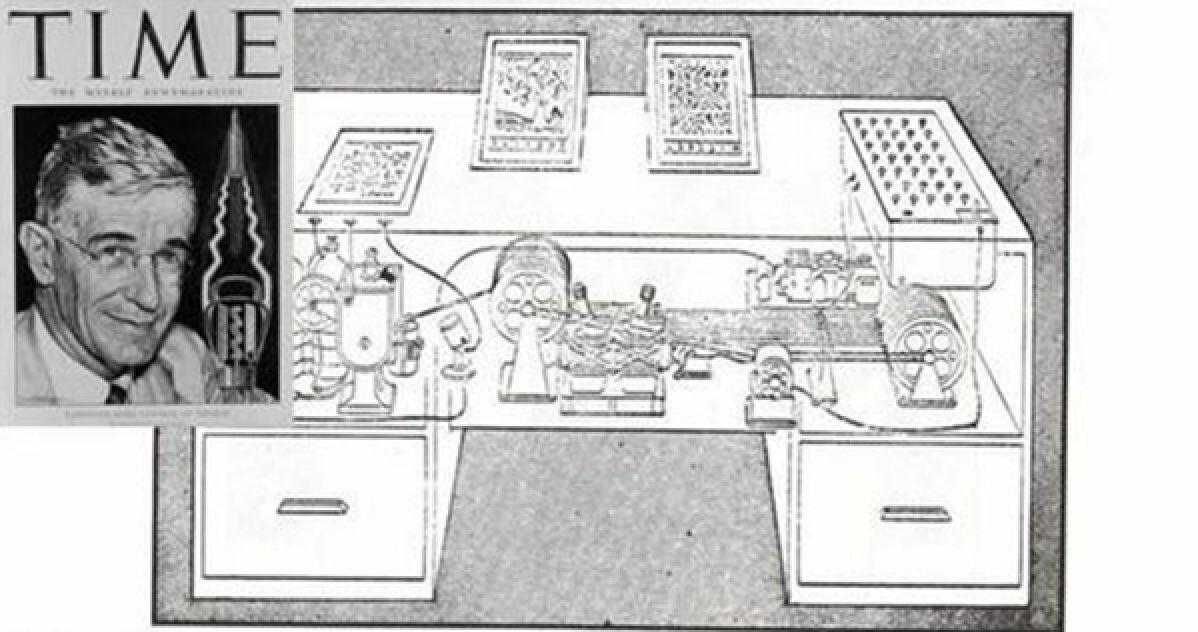04 Jul 2022
Is the Golden Thread a modern-day Memex?

A key inspiration of modern-day digital solutions, the memex is not a new start-up, cloud service or gadget, but rather a remarkable invention that dates back to 1945.
What is memex and who invented it?
Combing the words 'memory' and 'extender', the memex was a conceptual system created by Vannevar Bush. Intended to provide efficient access to research and findings, the memex was designed to be a navigation solution and archive of information.
Born in 1890, Vannevar Bush was a combined engineer, mathematician and scientist. A key intellectualist during the second world war, Bush was a proponent of technological innovation and entrepreneurship.
Due to his struggle with the inadequacy of paper-based indexing systems, Bush believed the methods of transmitting and retrieving information needed to be revised. After years of questioning the potential of augmented memory, Bush introduced his findings in an essay titled, 'As We May Think.' Originally written in 1936 but stowed away as war loomed, this historical piece of writing was first published in July 1945.
The article introduced Bush's latest invention, the memex. Derived from Bush's earlier work with analogue computing machines, the memex was a device for cross-referencing and recovering information. With a desk with viewing screens, built-in storage, selection buttons and a keyboard, Bush's memex would rapidly retrieve and display documents on demand.

Image Credits: Diagram of the 1945 Memex alongside Time Magazine's Vannevar Bush Front Cover
Memex in the form of a desk would instantly bring files and material on any subject to the operator's fingertips.
- As We May Think' original illustration caption.
Consider a future device… in which an individual stores all his books, records, and communications, and which is mechanized so that it may be consulted with exceeding speed and flexibility. An enlarged intimate supplement to his memory.
-Vannevar Bush, 'As We May Think' published in The Atlantic.
Depicted in the article, Bush described the memex as a personalised, comprehensive library that would be constantly updated and span generations. Parallel to how the human mind stores memories through association, users of the memex could add and link documents using what Bush called 'associative trails.'
The idea of automating intellectual processes seems obvious to us now- but in the early 1930s the idea of automating what was essentially a function within thought was radical.
-Quoted from Larry Owens academic journal, 'Vannevar Bush and the Differential Analyzer: The Text and Context of an Early Computer.'
The lifework of Vannevar Bush continues to inspire modern-day technologies. Although his device was never physically built, the concepts behind the memex have and continue to inform the development of the digital age. Hailed as the precursor to hypertext and the world wide web, pioneers Douglas Engelbart, Ted Nelson and Tim Bernes-Lee have each credited Bush's visionary device. Bush’s theorems continue to echo into the present as engineers of the metaverse use contemporary technology to further advance collaborative knowledge.
What is the Golden Thread and why is it important?
On April 28th 2022, The Building Safety Bill received Royal Assent and became an Act of Parliament. The Act contains new provisions, one of which includes the introduction of a digital golden thread. This Golden Thread of information will be a repository of centralised digital record-keeping for compliance data. Readily available to appropriate personnel, this single source of truth will hold all necessary documentation acquired throughout the entirety of a building’s lifecycle.
Although more specific requirements will follow in the secondary legislation, the government have instructed that the golden thread must be in an accessible, digital format that is accurate and up to date. Therefore, in preparation for the incoming building safety framework, building managers and estate owners must formulate a well-organised, easily accessed vault of information.
Is the digital golden thread a conceptual descendant of the memex and how do the two relate?
The digital golden thread carries the potential to become a building owner’s greatest tool. A place where information can be stored, organised and accessed with great efficiency- a modern-day memex if you will.
Accessed via a single source, like Bush's invention, the digital golden thread will utilise technology to create a thread of documentation. Plans, specifications, details, findings, safety reports and strategies are all positioned at 'the operators’ fingertips.'
An innovative navigation solution and information archive weaving the golden thread, Twinview provides building owners with a complete guide. All in one place, essential documents and real-time data are combined into a single browser-based platform. Designed for the property sector, users can effortlessly retrieve up-to-date asset information and as a result make smarter, more informed decisions.
A modern equivalent of Vannevar Bush's 'associative trails', with Twinview you can create an accurate digital audit trail with its built-in ledger recording who did what and when. With original design intent and subsequent changes recorded, building owners and managers can ensure accountability on a case-by-case basis.
Unlike Bush's stationary desk concept, Twinview can be accessed on the go using any device connected to the internet, anytime, anywhere. By leaving paper-based indexing systems in the past, not only can you retrieve information more efficiently, but you can also easily share it between important personnel such as tenants or the Building Safety Manager.
A modern version of Bush's 'slanting translucent viewing screens', Twinview's bespoke system generates customisable dashboards to help individuals prioritise building data.
Encouraging collaboration; owners, operations, and occupiers together can communicate and resolve issues productively using a built-in ticketing system and integrated tenant experience app.
Looking towards the future in 1991, Bush published 'Memex Revised'. A topic of discussion emerged in his writings that spoke to what we now refer to as artificial intelligence. Bush contemplated that if the trails were variable and open to growth, the memex may even poses the power to observe the owner's habits and extend its scope. Speaking to machine learning, the memex after a period of observation, could itself build a new trail of thought, 'even when the owner was not there.'
A final connection with memex, Twinview employs artificial intelligence to reduce both a building's energy costs and carbon output. Through collating, organising and referencing data during a period of consumption, Twinview in turn calculates and suggests where improvements can be made.
The central concepts behind the memex, golden thread and Twinview share a high degree of commonality; secure repositories that efficiently retrieve and display documentation on request. Three information management models ensure information is accurate, up-to-date and accessible. In 2022, we now have the hardware, software, and storage services that make the memex a reality and in the case of Twinview, take Vannevar Bush’s vision even further.
Book a demo to find out how utilising digital twin technology could benefit your building. Access essential documents and building data with 'exceeding speed and flexibility' via a single source of truth.
Book your one-on-one appointment with one of our specialists.
info@twinview.com
+44 (0)844 800 6660
London
24 Greville Street
Farringdon
London
EC1n 8SS
Newcastle
Spaceworks
Benton Park Road
Newcastle upon Tyne
NE7 7LX

